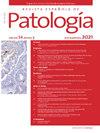Comparative analysis of Ki-67, α-SMA, and MMP-9 expression in oral submucous fibrosis and oral leukoplakia with/without dysplasia: Insights into malignant transformation mechanisms
IF 0.5
Q4 Medicine
引用次数: 0
Abstract
Background
The present study aimed to comparatively analyze the immunoexpression of Ki-67, Alpha Smooth Muscle Actin (α-SMA), and Matrix Metalloproteinase-9 (MMP-9) between Oral Leukoplakia (OL) and Oral Submucous Fibrosis (OSMF), both with and without dysplasia. The objective was to determine the potential role of these biomarkers in the diagnosis and prognostication of oral potentially malignant disorders (OPMDs) and their potential as targets for interventions.
Materials and methods
Immunohistochemical staining for Ki-67, α-SMA, and MMP-9 was performed on seventy formalin-fixed paraffin-embedded tissue blocks, comprising normal buccal mucosa (n = 10), OSMF (n = 30), and OL (n = 30) with 15 cases each of dysplasia and non-dysplasia. The expression of these markers was comparatively evaluated in OSMF and OL, with and without dysplasia.
Results
The immunoexpression of Ki-67, MMP-9, and α-SMA was found to be significantly higher (p < 0.001) in OSMF compared to OL for the respective dysplastic counterparts. Additionally, OSMF with dysplasia exhibited a significantly higher expression (p < 0.001) of these markers compared to OSMF without dysplasia.
Conclusions
The present study reports differences in cell proliferation rates, myofibroblast and MMP-9 expression between OSMF and OL. The higher expression of these markers in OSMF with dysplasia suggests accelerated disease progression and enhanced potential for transformation into oral squamous cell carcinoma (OSCC). These findings highlight variations in the tissue microenvironment of OPMDs, influencing their biological behaviour and prognosis.
Ki-67、α-SMA和MMP-9在口腔黏膜下纤维化和伴/不伴不典型增生的口腔白斑中表达的比较分析:对恶性转化机制的见解
本研究旨在比较分析Ki-67、α-平滑肌肌动蛋白(α-SMA)和基质金属蛋白酶-9 (MMP-9)在口腔黏膜白斑(OL)和口腔黏膜下纤维化(OSMF)中伴和不伴发育不良的免疫表达。目的是确定这些生物标志物在口腔潜在恶性疾病(OPMDs)的诊断和预后中的潜在作用,以及它们作为干预目标的潜力。材料和方法对70个福尔马林固定石蜡包埋组织块进行Ki-67、α-SMA和MMP-9的免疫组化染色,包括正常颊黏膜(n = 10)、OSMF (n = 30)和OL (n = 30),其中发育不良和非发育不良各15例。比较评价这些标志物在有和没有发育不良的OSMF和OL中的表达。结果Ki-67、MMP-9、α-SMA的免疫表达显著增高(p <;0.001),与相应的发育不良对照者相比。此外,伴有发育不良的OSMF表现出明显更高的表达(p <;0.001),与没有发育不良的OSMF相比。结论OSMF和OL在细胞增殖率、肌成纤维细胞和MMP-9表达方面存在差异。这些标志物在伴有不典型增生的OSMF中较高的表达表明疾病进展加快,转化为口腔鳞状细胞癌(OSCC)的可能性增强。这些发现强调了opmd组织微环境的变化,影响其生物学行为和预后。
本文章由计算机程序翻译,如有差异,请以英文原文为准。
求助全文
约1分钟内获得全文
求助全文
来源期刊

Revista Espanola de Patologia
Medicine-Pathology and Forensic Medicine
CiteScore
0.90
自引率
0.00%
发文量
53
审稿时长
34 days
 求助内容:
求助内容: 应助结果提醒方式:
应助结果提醒方式:


